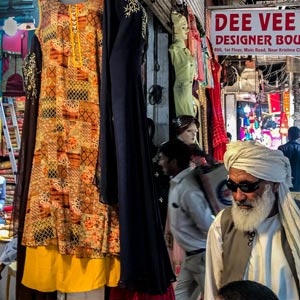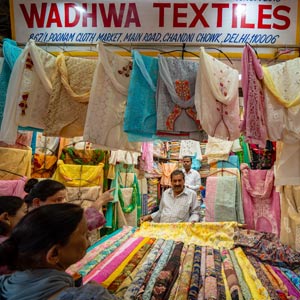Feature: The Search for a Master Watchmaker
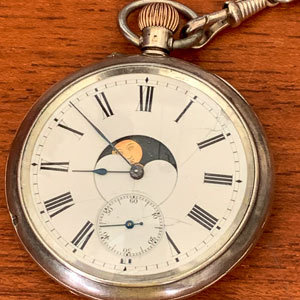
(Left) The fabled timepiece, restored to its original pristine condition after a seemingly impossible quest of finding someone who would perform just such a miracle.
One man’s quest to get a family heirloom repaired takes him from the U.S. to the narrow streets—overcrowded with people, products, and personality—of Delhi’s famous Chandni Chowk, to come face-to-face with perhaps the only man alive who could fulfill his dream of restoring a precious timepiece, one that meant much more to him than the sum of its parts.
It was a promise made 67 years ago....
A fascinating family relic acquired around 1890, a unique pocket watch, belonging to my grandfather, was the object of my fascination. I was 11 years old, the year was 1952, and we lived in a small town called Dehra Dun, nestled in the foothills of the Himalayas. This pocket watch was made of pure silver, about 2 inches across, with a beautiful white face. It had a small second hand near the six o’clock position and a moon phase display. It had a back that would open up to display the date, day, and month. I’d hold it to my ear to hear it ticking. It was not a loud tick, but a very pleasing, hissing tick.
Every morning, my grandfather would pick up the watch from the mantelpiece, wind it, put it in his pocket till night, and then put it back on the mantelpiece at bedtime. Whenever I found the watch lying around, I would climb up to admire it. Understanding my fascination, Granddad would often let me wind it, cautioning, “Gentle, do not wind too much or you will break the mainspring.”
One day, I mustered up enough courage to ask Granddad if I could have the watch. He said, “Yes, you can, but you have to grow up first.” I knew Granddad always kept his word, but it meant I would have to wait for many, many years. That was 67 years ago.
Time slipped by. Granddad passed away. We moved many times in India, and finally came to the USA. My fascination with watches continued and I bought many watches, both manual and electric. But I often thought of the shiny silver pocket watch, and the promise. But then, it seemed so far away—a different country, a different generation, and perhaps it was always going to be just a pleasant memory.
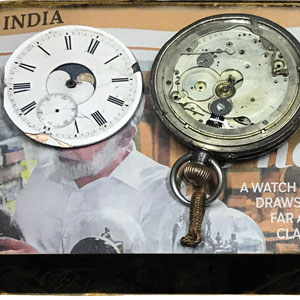
(Right) The badly damaged object of the author’s fascination when it suddenly reappeared in his life after 67 years.
To my extreme surprise and joy, the fabled watch indeed showed up in my life again. Mom recently found it in an old cardboard box. She said she was shipping it to me. My long-awaited dream was coming true and I could barely wait to get the package. When it came, with great joy, I opened the small cardboard box, yearning to hold the watch again. But my joy was short lived, and expectations were dashed to the ground. Its glass was broken, the hands were gone, and the white face was chipped and falling out. The winding mechanism was jammed and nothing moved. The watch was nothing like what I remembered. Fate had indeed dealt me a cruel hand.
Discouraged as I was, I figured I could get it repaired and restored. So I took it to many nearby watchmakers in the San Francisco Bay area. They all looked at it, checked its condition and mechanism, and gave the same answer: “it’s too old, badly damaged, and impossible to find parts.” However, in the next few days, I was traveling to Atlanta—a town where I had lived for the previous 20 years—and knew quite a few watchmakers and watch dealers. There I went to Decatur, then Buckhead and Roswell, but got the same answer from all of them: that it was impossible to fix. It was indeed very disheartening, but I still had one hope. I was going to New Delhi, India, in March that year. Perhaps I could find some craftsman out there who could take on this daunting task.
|
|
|
The narrow streets and the wall-to-wall packed tiny stores of Chandni Chowk.
Soon after landing in India, I set out to fulfill my mission. My first stop was Khan Market, followed by several other watchmakers in and around New Delhi. All their answers were the same: “can’t be repaired.” A couple of them suggested going to Old Delhi, to the “Ghari Bazaar” (Bazaar of Watches) near Chandni Chowk. This street, lined with hundreds of tiny watch shops also has several watchmakers, some specializing in new watches, some in old, and some in antiques. It is also the home of several renowned watchmakers who have been in business for 50-60 years and have built a reputation for fixing old watches. I spent all day talking to several of them and showing them the watch. They all said it was impossible to fix.
One of the old watchmakers in the Bazaar suggested I go back to New Delhi and try a watch shop called Gangoly Brothers, near Rivoli Cinema. They were renowned watchmakers, had been in the business for decades, and still had a master craftsman/watchmaker from the old days.
The next day, very eagerly, I trudged to Gangoly Brothers. The salesman at the main floor asked me to climb up two flights of stairs to the top of the building to see their watchmaker. There he was, Pandit ji, a very old man sitting at the end of the hall behind a glass cabinet. He took the watch, examined it very carefully, and finally said, “No way, it cannot be fixed.” I pleaded, “Pandit ji, surely there must be someone in this great city who can fix this watch.” He answered very slowly, “You cannot find parts for these old watches, and most of the craftsmen who worked on them have died or moved away from Delhi.”
I hung around and nudged him for a referral. He finally said, “There is one super craftsman, a very old fellow by the name of Ikhlas Ahmed Shafi, way out near the Fatehpuri mosque in Chandni Chowk, who may be able to help you. Ikhlas is not only good but also makes the hard-to-get parts. Show it to him. If he says no, then nobody else can help you.” Pandit ji further said, “He sits at Packard Watch Company in Chandni Chowk,” and he warned, “When you go to the shop, do not talk to the owner of the shop, for he will say ‘no.’ Instead, tell the owner you want to talk only to the gharisaaz (watch craftsman), and show your watch to him.”
I thanked Pandit ji profusely, and early next morning I eagerly left for Chandni Chowk, once again. It’s one of the oldest commercial streets in the Old City. There are hundreds of shops on both sides of the street, with thousands of people on the street and sidewalks. One can barely walk from shop to shop. And the street is jammed with cars, motorcycles, rickshaws, and pedestrians. I took the Metro and after a 20-minute crawl through the crowded streets, I found Packard Watch Company.
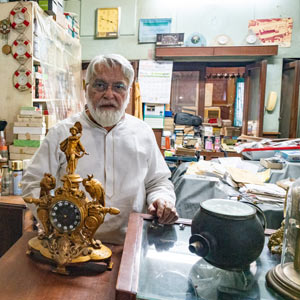
(Left) Ikhlas Ahmed Shafi, the legendary watchmaker who did exactly what dozens of other veterans of this craft—from San Francisco to Atlanta and even to those on “Ghari Street” in Old Delhi—said was impossible to do. For the author, the cherry on top was the fact that Ikhlas and he attended the same storied high school just a few years apart.
I walked inside, and the owner asked, “How can I help you?” Well coached, I said, “I need to see the karigar (the artisan watchmaker).” He pointed to a man sitting at one end of the shop. There he sat, Ikhlas Ahmed Shafi, the master craftsman, my last hope and savior of my dreams. He was an elderly man, very stately looking, with a white flowing beard and dressed in traditional Muslim clothes—salwar and achkan. He looked at my watch and then asked his assistant to hand him his screwdriver. The case would not open. In very fluent Urdu he said, “This needs to go to my workshop. Follow me.”
Before I could say anything, the old gentleman got up, picked up two plastic bags, one in each hand and started walking down Chandni Chowk. For an old man, he walked pretty fast and I had a hard time keeping up with him. As he passed the small shops, he would stop for a moment to exchange pleasantries with the shop owners and then move on.
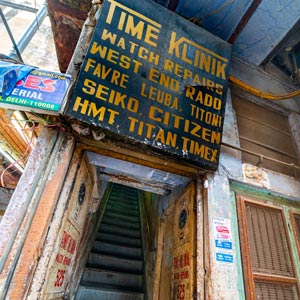
(Left) This humble hole-in-the-wall led to dauntingly steep steps for the 75-year-old author with a knee replacement—but what was in store for him at the top of the staircase made it all worthwhile.
Finally, as we came to the end of Chandni Chowk, he turned left into a narrow street, much narrower than the main Chandni Chowk we were on. After a twirl on this narrow street, he turned left to another side street, even narrower than the first. I followed him, and we came to a hole in the wall. He turned left into it and disappeared. When I reached there, I saw a doorway with a painted sign, “Time Clinix.” A steep, narrow staircase, no more than 4 ft wide, went up and up.
It seemed pretty daunting to climb up all the way. I had had my knees replaced, so I hesitated, but finally decided to follow. When I was only half done, he was already at the top. He asked, “Are you tired?” I replied, “Yes, it depends on age.” He asked, “How old are you?” I said, “Seventy-five, and how about you?” He said, “I am seventy.” And I chirped, “You are a young man!”
When I finally landed, I saw a small room with hundreds of old watches, wall clocks, cuckoo clocks, and countless small cardboard boxes which appeared to have watch parts. Ikhlas had a large desk and work area near the wall. Next to him was another room, where his assistant was repairing watches as well.
He sat down, asked for the watch, and immediately set to work. He examined it very carefully. He peered at the front of the watch—with no glass, no hands, a chipped face, and a jammed winding mechanism. He opened the back and a part fell out; the balance wheel was gone. After a long five minutes spent carefully examining all parts, he put everything back, closed the watch, and looked at me intently.
He said, “There is lot of work on this watch, cosmetic as well as in the actual mechanism. Many parts are missing. It requires a lot of skill—but it can be done!”
My heart skipped with joy. I wanted it done, but I did not want to appear too anxious and pay a high price, so I asked, “How long will it take for you to complete the job?” He said, “It has a lot of work, so it will take two weeks.” I complained and asked how much it would cost, and he said, “Twelve thousand rupees.” A quick calculation in my head showed it was approximately $170. My budget was $200, so I told him, “It’s a deal. Let us move ahead.”
Suddenly, Ikhlas switched to English. “Sir, this is a museum piece, and when I restore it, it will be a first-class job. And believe me, you will not find anyone else anywhere who can do this work.” I was struck with his command of English and could not help but remark, “You speak such fluent English!” He replied, “Yes, I speak fluent French as well. I was trained in Switzerland.”
Then he explained that he had gone to school in New Delhi at St. Columba’s High School, an Irish Christian Brothers school. What a coincidence! We were in the same school at the same time but in different classes. On learning that, he immediately had his assistant make special tea and serve it to me in a fine china cup and saucer.
Over tea, we had a lot to talk about—our common teachers and now-famous schoolmates like Deepak Chopra, the author and thinker, and Shah Rukh Khan, the Bollywood superstar. Then Ikhlas showed me his annual class pictures, with all the boys dressed in the school uniform and in shorts. He looked completely different now. He had achieved fame, as was evident in the many newspaper articles he showed about himself, and was dressed in more conservative clothes. It was already 12:45 pm and time for Ikhlas’s Friday prayers at the mosque, so I left for home.
Two weeks passed slowly, and at their end I called Ikhlas. The watch was ready. It took me two hours to get there, with a ride on the Delhi Metro followed by an electric rickshaw in Chandni Chowk. It seemed like traffic was moving in all four directions on the street. Every now and then the rickshaw would come to a dead halt with a gridlock. Traffic was locked up in all directions and nobody wanted to give way. And just as suddenly as gridlock appeared, it would disappear!
The ride seemed like an eternity. I was finally dropped off and walked the last half mile. I climbed up the steep stairs, my heart beating fast and not knowing what to expect. Ikhlas greeted me. He went back to retrieve my treasure and finally handed it to me.
Eagerly, I laid my eyes on the watch. It looked exactly as I remembered. It had the glass, the hands, and the dial, all looking new. The second hand was turning, and the moon phase was working. The winding mechanism worked, and the hands turned. I held the watch to my ear and I heard the same hissing ticking as I had 60-odd years ago. It was unbelievable.
I closed my fist and tightened my grip on the watch. My eyes closed and I felt my body warm with joy and happiness flowing through every vein. A thousand memories flashed through my mind—my grandfather’s assurance, the longing over the years, and finally the ordeal in finding a master watchmaker. The long journey was over. As I dwelled in ecstasy, all I could say was, “Wow, wow! A dream come true. A promise made, a promise kept!”
Pavan Rai, CEO/President of Raico International, is a visionary Information Technology Executive. Formerly he was CIO and VP of Care USA in Atlanta.
Enjoyed reading Khabar magazine? Subscribe to Khabar and get a full digital copy of this Indian-American community magazine.
blog comments powered by Disqus




